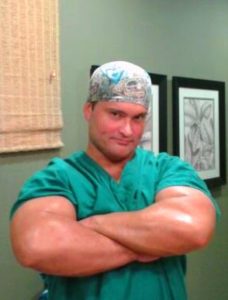Dr. Kenneth Hughes is a board-certified plastic surgeon based in Los Angeles, California and is the medical director of Hughes Plastic Surgery and his fully accredited, state-of-the-art surgery center. At Hughes Plastic Surgery, Dr. Hughes combines his unique talent, seasoned experience, and top-tier training to offer the highest standards in plastic surgery to all of his patients throughout the Beverly Hills and Los Angeles areas and all over the world.
Dr. Kenneth Hughes has received some of the most exceptional training that one working in cosmetic plastic surgery could have. He attended Harvard University for his undergraduate education where he studied Biology, graduating cum laude with his bachelor of science in 1999. During his tenure as a student at Harvard University, Dr. Hughes distinguished himself as an academic by being Harvard College Merit Scholarship winner all four years of his education, 1995 – 1999. He also distinguished himself as a student-athlete as a four-year varsity Letterman in Track and Field.
Following his undergraduate studies at Harvard University, Dr. Hughes accepted a host of academic scholarships to attend the University of Alabama School of Medicine, where he graduated with honors and AOA with his Doctorate of Medicine in 2004. He scored in the 99th percentile on the national licensing boards and was the recipient of multiple merit scholarships throughout his tenure.
From 2004 to 2010, Dr. Kenneth Hughes was selected and completed general and plastic surgery integrated residency at the University of Kansas Medical Center (only 70 positions in the US). Upon graduating from residency, Dr. Hughes was selected to the year-long Harvard Cosmetic Plastic Surgery Fellowship (1 position in the US). In addition to the fellowship training, Dr. Kenneth Hughes served as a Plastic and Reconstructive Surgery clinical instructor at Harvard Medical School. Dr. Kenneth Hughes received his board certification by the American Board of Plastic Surgery the following year after excelling on the national written and oral examinations.
Dr. Hughes has authored numerous plastic surgery publications including scholarly journal articles and textbook chapters in which he seeks to share his knowledge and further the myriad of contributions that he has made to the plastic surgery field. Dr. Kenneth Hughes has given countless lectures at institutions, regional meetings, and national and international meetings.
As a professional, Dr. Kenneth Hughes built Hughes Plastic Surgery with a commitment to set the highest standards in plastic surgery and consistently exceed the expectations of his patients. He wants to help patients assimilate the information they find online, demystify some of the technical considerations, and debunk common misunderstandings so that patients may identify their best options. Dr. Kenneth Hughes has performed thousands of plastic surgery procedures and continues to distinguish himself as one of the very best in the plastic surgery realm. Dr. Hughes is an expert in many plastic surgery procedures including liposuction, Brazilian buttlift or BBL, tummy tuck, mommy makeover, breast augmentation, breast lift, and rhinoplasty.
Dr. Kenneth Hughes, Harvard-educated, Harvard-trained Plastic Surgeon in Los Angeles, has been selected best plastic surgeon in Los Angeles in 2020, 2021, and 2022 by Top Plastic Surgeon Reviews, WIMGO, Three Best Rated, Kev’s Best, Caredash, and Top 100 registry.

Dr. Kenneth Hughes Best Plastic Surgeon in Los Angeles for 2021 and 2022
 Dr. Kenneth Hughes Selected Among Best Plastic Surgeons In Los Angeles for 2018, 2019, 2021, and 2022
Dr. Kenneth Hughes Selected Among Best Plastic Surgeons In Los Angeles for 2018, 2019, 2021, and 2022

Dr. Kenneth Hughes
Dr. Kenneth Hughes’s Subdermal Brazilian Buttlift Technique – The Safest and Best Option
Dr. Kenneth Hughes switched to a subdermal method of transferring fat to the buttocks and hips in 2015. During that 7+ years of the subdermal method no fat emboli have occurred. The subdermal method utilizes a blunt large cannula that is placed directly under the skin so that the tip is constantly visualized. In other words, it is impossible to be more superficial with the injection or safer. The subcutaneous method can be injected into the plane between the skin and the muscle fascia. The problem with this method is that subcutaneous thickness varies with the individual and the various areas of the buttock. Therefore, some surgeons may not be able to accurately gauge depth during the procedure relative to the muscle. Some have advocated ultrasound to presumably help guide cannula position. The problem is that any deviation from the subdermal method has the ability to deliver fat more deeply, whether or not an ultrasound probe is used.
In these fat transfer procedures which utilize liposuction for the fat harvest, these cannula are not only used to inject in hundreds of areas but they are moved in and out of those areas. The only way to assure that the fat is kept above the muscle is to keep injections subdermal. An ultrasound if done correctly can potentially show the cannula and the plane of injection above the muscle. However, the ultrasound probe would have to follow the fat injection cannula millimeter by millimeter to ensure that there is no deviation. Not only that but the plastic surgeon would have to move in one millimeter increments and interpret the images from the ultrasound probe from each of those millimeter segments.
So the technical issue in this discussion is one of practicality. Ultrasound and cannula mobilization so that one can be permitted to inject more deeply than the subdermal level presents a cumbersome task. Even if performed in a very precise fashion, certain areas that are mapped by ultrasound will not be mapped fully. That is a given. In addition to prolonging surgical time, the technique has a problem with the fluidity phenomenon necessary in surgery. Fat is not merely transferred to one location and then that area is finished. Rather the surgeon must be able to inject into certain areas and be able to come back to those areas as the buttocks and hips take shape to assure symmetry and projection. Thus, this mapping would have to be done and redone to ensure safety with a subcutaneous injection. Finally, the usefulness of the ultrasound as the procedure continues becomes less and less reliable as hundreds or even thousands of milliliters of fat are dispersed into these areas. Thus, the interpretation of the ultrasound to differentiate subcutaneous fat from injected fat can be an exercise in futility. If the plastic surgeon injects precisely and only at the subdermal level, the cannula will never enter a blood vessel in the subcutaneous fat or the muscle. In addition, the cannula tip visualization obviates any need to perform ultrasound at a deeper level, as only the most superficial level is injected. If fat is injected just deep to the tiny vessels of the subdermal plexus (which are too small to enter with a 4 mm cannula or larger), then the surgeon does not have to worry about fat embolus either superficial or deep to the plane of injection.
While discussions of this nature can be confusing due to terminology or presentation, Dr. Kenneth Hughes presents a very logical methodology that he employs to present the best and safest results for the patients. For more information, please visit Dr. Kenneth Hughes’s main Brazilian buttlift page.
Please watch Dr. Kenneth Hughes’s Video on Body Lifts in Los Angeles and Beverly Hills
https://www.youtube.com/watch?v=tOUl6BHrAhA
For more about Dr. Kenneth Hughes and his achievements in plastic surgery, check out his blog!

